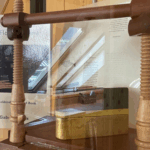There are lots of different stitches used in bookbinding, but the Kettle stitch is – to me – the most important. I use this fundamental stitch in every sewn book with three or more sections or signatures. In this post, I’ll explain more about the Kettle, when to use it and how to sew one correctly.
What is a Kettle stitch?
First things first – what is the Kettle stitch, anyway?
The Kettle is a traditional stitch used in bookbinding to secure sections (also called signatures) together at the head and tail of the book. This makes the Kettle an essential stitch, because the head and tail are the weakest points on a multi-section sewn book.
The word “kettle” is derived from an alteration of the German word “ketteln”, which means to “catch up a stitch.” When used in bookbinding, it makes sense because the stitch literally “climbs up” the book block at the head and tail by circling each stitch.
Where is the Kettle stitch used in bookbinding?
Space is reserved for a single row of Kettle stitches at the head of the spine and another at the tail. These rows typically start around 8-12mm in from the edge (see below). While the other sections of the book may be sewn using the French Link Stitch or over tapes as the photo below demonstrates, the Kettles are always separate at the head and tail.

Why use the Kettle stitch instead of some other technique?
Kettle stitches help to secure sections to build a strong binding and are not (usually) considered decorative. The stitch itself has a low profile (it climbs instead of chains), making it easier for bookbinders to cover the stitch with supportive spine treatments like mull and liners.
How do you form a Kettle stitch?
Kettle stitches link two sections together, so the first Kettle is sewn after the third section has been sewn but before the fourth section is added.
You might wonder, “What is securing the second section to the first?” If so, great question!
In most bindings, the first and second sections are usually held together by a square knot at the tail. Square knots are strong, so the Kettle isn’t introduced until a third section is sewn.
Here are the steps required to sew a Kettle stitch. See the photos below for reference.
- Once you’ve sewn the third section into place, your thread should appear outside of the book
- Now move the needle behind the thread holding the previous two sections together
- Pull the thread until a small loop forms (be careful not to pull it out)
- Run the needle through the loop and pull upward
- Using your fingers, press the sections down to hold them in place securely and pull until the knot is formed
- Once the knot is in place, lay the 4th section down and continue sewing. At the end of the fourth section, you’ll tie a new Kettle stitch securing the 4th to the 3rd and so on






Full Video Tutorial: How to Sew a Kettle Stitch for Bookbinding
The Kettle is also a “direction changing” technique
As a side note, the Kettle is also known a “direction changing technique” in bookbinding. With each Kettle, the sewing direction changes from either left to right or right to left.
In our example above, I was sewing to the left when it was time to create the Kettle stitch attaching the third signature to the second. Afterward, I added the fourth signature and started sewing to the right. This continues on until the book is complete.
I hope this overview and quick tutorial was helpful!
More bookbinding goodness
✨ What tools do I need to get started bookbinding?
- Bookbinding Tools & Supplies Quick Start Guide – learn all about book making tools, which to buy first & where to go online
- Pick up my popular Complete Starter Bookbinding Tools Kit – all the bookbinding essentials in one spot
🌟 Looking for a simple way to start making books?
Try a Complete Book Materials Kit. Each one has everything you need (+ tutorials & videos) to make a beautiful book without all the fuss.
Thank you for taking me along on your book making journey!
Misty












